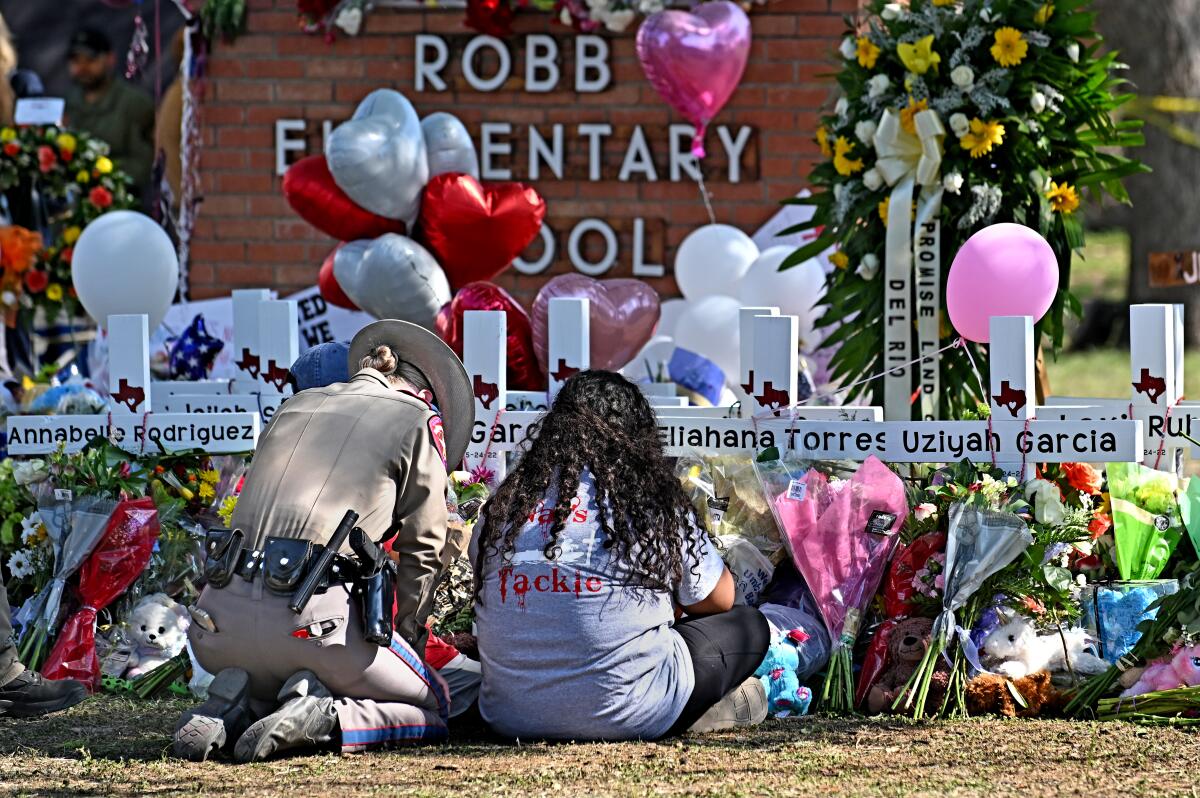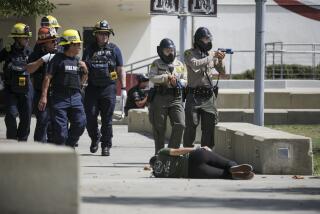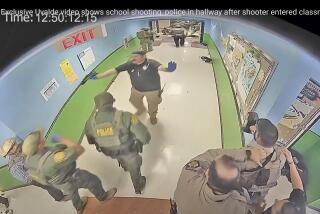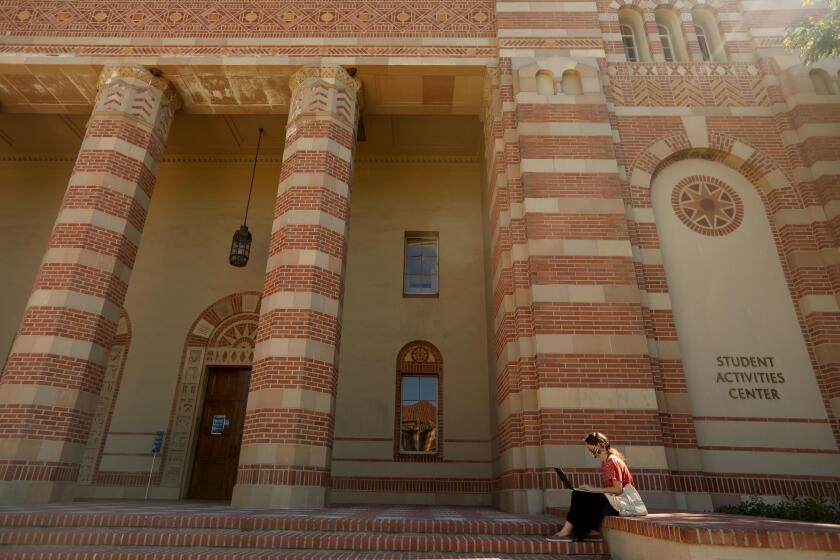As Texas eases access to guns, bill urges tourniquet training for elementary schoolchildren

- Share via
About a year after a gunman massacred 19 children and two teachers in Uvalde, Texas, a bill has been introduced by a state lawmaker to offer annual training to elementary schoolchildren on how to tie tourniquets or pack bleeding wounds during mass-casualty incidents.
The May 24, 2022, shooting at Robb Elementary School led a Democratic state representative to propose expanding an existing state law that requires school districts to offer annual instruction on bleeding control techniques starting in the seventh grade. The new bill could lower the training threshold to elementary schoolchildren.
“In a perfect world, this legislation wouldn’t be needed,” state Rep. Barbara Gervin-Hawkins of San Antonio, who wrote the bill, said in a statement. “Unfortunately, with mass shootings becoming so common in our state, it is necessary to give students tools that could help them save a life if they are confronted with this terrible situation.”
Gervin-Hawkins also spearheaded the state’s current law, which was enacted in response to the 2018 shooting at Santa Fe High School.
The bill is a prime focus in a state that has relaxed access to firearms in recent years as the nation has endured increasing gun violence. It also highlights the stark reality that schoolchildren in America face daily.
According to the bill, “bleeding control stations,” which in 2020 became required on district and charter school campuses, must contain tourniquets “approved for use in battlefield trauma care by the armed forces of the United States,” bleeding control bandages, emergency blankets, gloves, scissors and instructions on preventing blood loss following a traumatic event. In addition to lowering the age limit, the bill requires the installation of emergency devices that can be activated to alert authorities.
The bill originally proposed lowering the age to third grade, but a new bill introduced in the Select Youth Health and Safety House committee would revise it to fourth grade, Gervin-Hawkins’ office confirmed. The new bill also requires that a behavioral health professional, such as a guidance counselor, be present for the training for students in these grades.
Families can opt to keep their children out of the training, consistent with the existing law.
The Texas Elementary Principals and Supervisors Assn., or TEPSA, opposes the bill, with a representative saying it doesn’t make sense for “a child to be involved in something like this.”
“It is not appropriate,” Mark Terry, TEPSA’s deputy executive director, said. He said parents have also shared their disapproval of the bill with him.
Several states have laws similar to the Texas measures, part of the American College of Surgeons’ nationwide Stop the Bleed campaign, born in the wake of the 2012 massacre at Sandy Hook Elementary School in Newtown, Conn. The initiative aims to empower bystanders to aid victims in various traumatic circumstances, from mass shootings to car accidents, by equipping the public with knowledge and tools to perform lifesaving measures until first responders arrive.
California enacted a law last year that requires larger newly constructed buildings to provide “trauma kits” that contain first aid items, including tourniquets. Lawmakers are considering requiring the kits in older buildings and including Stop the Bleed training for all high school students, similar to the state-mandated CPR training required since 2016.
Lawmakers proposed 19 similar bills — several of which became law — in statehouses around the country, including Texas, according to the Stop the Bleed program, which promotes and tracks legislation pertaining to trauma bleeding control. The bills and laws cover a wide spectrum, including funding, supplies and instruction.
But many bills have stalled. The proposed Texas bill is unlikely to move forward from the committee before the legislative session closes later this month.
“I understand that there are concerns about younger students being exposed to this kind of material,” Gervin-Hawkins said in an emailed statement. “The experts we have spoken to have agreed that young kids can learn the techniques taught in this training. This training provides valuable life skills for these students, even outside of the context of school shootings.”
Schools, public health officials and community groups around the country have taught lifesaving, first-aid techniques, including bleeding control, to students, from Montana to Washington, D.C., to Florida.
In 2019, Arkansas adopted a law that requires public schools to provide bleeding-control training to high school students. But Texas, which was the first state to enact such legislation that would apply to students as well as school personnel, appears to be the first state to draft a bill that would make training available to elementary schoolchildren.
“The current legislation to reduce the age of training to children in grade 3 is not about whether you can teach the child the skill but whether we should teach the child the skill,” Linda James, a clinical assistant professor at Sam Houston State University’s nursing school, wrote in a public comment on Legiscan, an online legislative tracker. “Questions about intention to use the skill and retention of the skill have not been clearly and consistently identified in the research.”
Missy Anderson is a pediatric trauma program manager at Denver Health Trauma who has been teaching crisis care to children ages 5 to 13 since 2018. She’s hosted training for Girl Scout troops, lifeguard organizations, church groups and sports teams. When working with small children, Anderson, who developed her own curriculum, uses phrases including “big bleeding” and “little bleeding” to talk about injuries and relates packing wounds to stuffing a Build-a-Bear or a backpack, concepts she says they can grasp.
“I’ve never had any questions that make me think, well this child is not understanding it or this young child is scared,” she said.
Instruction is given in a safe environment, and the course itself is not about violence, she said. “It’s about saving people who are bleeding,” Anderson said. But she added that some of her students have used mass shootings as an example of what might cause severe bleeding or injury. Anderson underlines personal safety as a priority and clearly communicates that it’s OK not to step in, she said.
“I don’t know if they’re going to help,” she said of the children she’s taught. “But I just powered them with knowledge and the ability to go out and help if they want to help.”
Dr. Chethan Sathya, a pediatric trauma surgeon and director of the Center for Gun Violence Prevention at Northwell Health, called teaching such trauma care techniques to children as young as third grade ineffective.
“Pushing back against this doesn’t mean we’re not for lifesaving measures that civilians can use,” said Sathya, who has taught Stop the Bleed courses to high school students and others. But he said the idea that a child can apply a tourniquet or pack a wound in an emergency situation like a mass shooting is highly improbable. It also doesn’t address the core issue of gun violence, he added.
“The idea that it’s a solution to preventing deaths in mass shootings is ridiculous,” he said.
Texas has in recent years made it easier for residents to acquire guns by weakening existing gun regulations, like eliminating its conceal-carry license requirement.
Gun control proponents won a significant victory recently when a bipartisan committee of the state Legislature voted Monday to advance a bill raising the minimum age to purchase AR-15-style rifles. The bill followed the deadly mass shooting at a mall in Allen, Texas, over the weekend. But the bill missed a vital deadline to be considered for passage Tuesday night and must be reintroduced at a later date.
More to Read
Sign up for Essential California
The most important California stories and recommendations in your inbox every morning.
You may occasionally receive promotional content from the Los Angeles Times.











